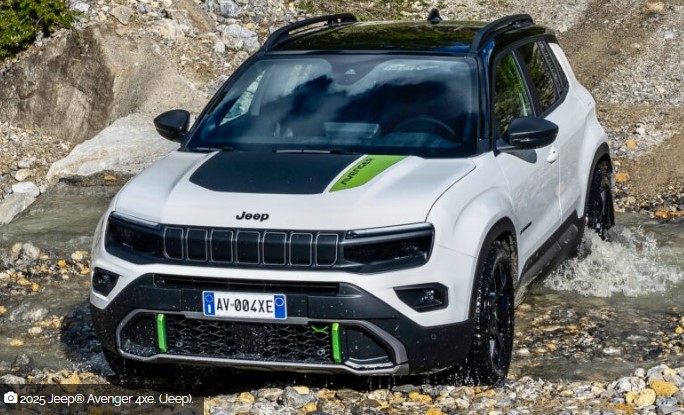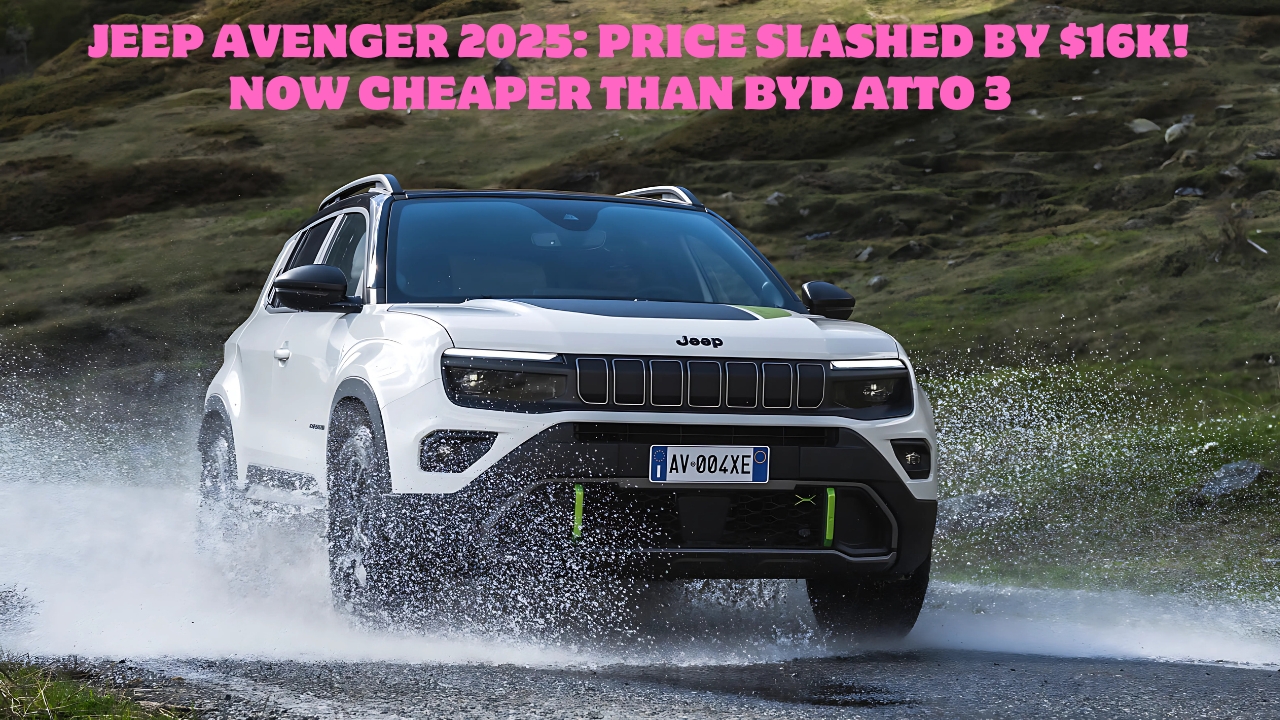2025 Jeep Avenger EV : Australia’s electric vehicle (EV) market is heating up, with 2025 bringing fierce competition in the affordable SUV segment. A standout development is the Jeep Avenger EV, which, thanks to a significant price cut, now undercuts the popular BYD Atto 3, positioning itself as one of the most affordable electric SUVs in the country.
This article explores the implications of this price drop, compares the two vehicles, and evaluates their appeal for Australian buyers seeking value, performance, and style in the rapidly evolving EV landscape.
The Price Slash: Jeep Avenger EV Takes the Lead
In a bold move, Jeep Australia slashed the price of its first-ever fully electric vehicle, the 2025 Jeep Avenger, by up to $16,000, making the base-model Longitude available from $40,000 drive-away. This strategic reduction, announced in May 2025, positions the Avenger as a direct competitor to the BYD Atto 3 Essential, priced at $39,990 plus on-road costs, which translates to approximately $42,000–$44,000 drive-away depending on the state.
This makes the Avenger one of the cheapest electric SUVs in Australia, undercutting not only the Atto 3 but also rivals like the Hyundai Kona Electric ($54,000 plus on-roads) and the Chery Omoda E5 ($42,990 plus on-roads).
The Avenger’s price cut comes at a critical time. With only 21 units sold in 2025 up to April, according to VFACTS data, Jeep needed to boost the Avenger’s appeal against dominant players like the Tesla Model Y (3,394 sales in the same period) and the BYD Atto 3, which ranked as Australia’s fifth best-selling EV in 2024.
By aligning its pricing with the budget-conscious segment, Jeep aims to capture a larger share of the market, particularly among urban buyers seeking a compact, stylish, and capable EV.
Jeep Avenger EV: A European-Designed Urban Warrior

The Jeep Avenger, designed in Italy and built in Poland, is a subcompact SUV measuring 4,080mm in length, making it smaller than the Atto 3 (4,455mm). Despite its compact footprint, it offers a claimed driving range of 396km (WLTP), powered by a 54kWh battery and a 115kW/260Nm front-wheel-drive electric motor.
The Avenger can charge from 20% to 80% in 24 minutes at a 100kW DC charger, making it practical for city dwellers with access to fast-charging infrastructure.
Jeep has infused the Avenger with its brand DNA, incorporating Selec-Terrain and Hill Descent Control, along with 200mm of ground clearance and a 20-degree approach angle for light off-road capability. This sets it apart from many competitors in the subcompact EV space, which prioritize urban efficiency over versatility.
The base Longitude model comes well-equipped with a 10.25-inch infotainment touchscreen, Apple CarPlay and Android Auto, LED headlights, 17-inch alloy wheels, and safety features like autonomous emergency braking (AEB), adaptive cruise control, and lane-keep assist.
Higher trims, such as the Limited ($45,000 drive-away, estimated) and Summit ($51,000 drive-away, estimated), add blind-spot monitoring, rear cross-traffic alert, leather-accented seats, and a sunroof.
The Avenger’s lightweight design (1,520kg) contributes to its nimble handling, described as “sporty” and “planted” compared to the Atto 3. Its European chassis tuning and 215mm low-profile 18-inch Goodyear tyres (on higher trims) offer a dynamic driving experience, ideal for Australia’s urban and coastal roads.
BYD Atto 3: The Established Champion
The BYD Atto 3 has been a trailblazer in Australia’s affordable EV market since its launch, earning a reputation for value, technology, and reliability. For 2025, BYD introduced the Atto 3 Essential, priced at $39,990 plus on-roads, replacing the Standard Range model and shaving $4,509 off the previous entry price.
The top-spec Premium, now at $44,990 plus on-roads, also received a $2,509 price cut, making the Atto 3 range highly competitive.
The Atto 3 Essential features a 49.92kWh lithium-iron-phosphate (LFP) Blade battery, offering a 345km WLTP range, while the Premium’s 60.4kWh battery extends this to 420km. Both models use a 150kW/310Nm front-wheel-drive motor, with the Essential achieving 0–100km/h in 7.9 seconds and the Premium in 7.3 seconds. Standard equipment includes a 12.8-inch rotating touchscreen (15.6-inch on Premium), synthetic leather seats, keyless entry, and a comprehensive safety suite with AEB, blind-spot detection, lane-keep assist, and adaptive cruise control. The Premium adds a panoramic sunroof, powered tailgate, and wireless charging.
Recent updates for 2025 include Continental tyres for improved grip, a larger touchscreen on the Premium, and subtle design tweaks like body-colored rear panels. However, the Essential sacrifices features like the sunroof and wireless charging to hit its lower price point, making it less luxurious but more budget-friendly.
Head-to-Head: Price, Features, and Performance
Price and Value
The Jeep Avenger Longitude’s $40,000 drive-away price gives it a slight edge over the Atto 3 Essential, which, after on-road costs, typically exceeds $42,000. However, the Atto 3 Premium ($47,000–$49,000 drive-away) offers more features than the Avenger Longitude and competes closely with the Avenger Limited in price and equipment.
For budget-conscious buyers, the Avenger’s drive-away pricing simplifies cost calculations, while the Atto 3’s lower base price before on-roads may appeal to those willing to forgo some features.
Performance and Range
The Atto 3’s 150kW/310Nm motor outperforms the Avenger’s 115kW/260Nm unit, offering quicker acceleration. The Premium’s 420km range also surpasses the Avenger’s 396km, though the Essential’s 345km falls short. For city driving, the Avenger’s lighter weight and agile handling may appeal to those prioritizing responsiveness, while the Atto 3’s power and range suit longer commutes or regional travel.
Features and Practicality
The Atto 3’s rotating touchscreen and spacious interior cater to tech-savvy families, with a 440L boot compared to the Avenger’s 380L. However, the Avenger’s premium European design, off-road capability, and competitive servicing costs ($1,250 over five years vs. $1,628 for the Atto 3) add appeal for buyers seeking a blend of style and utility.
Safety
Both vehicles carry five-star ANCAP ratings, with comprehensive safety suites. The Avenger’s base model lacks blind-spot monitoring and rear cross-traffic alert (standard on higher trims), while these are standard across the Atto 3 range, giving BYD an edge for safety-focused buyers.
Market Context: Why This Matters for Australians
Australia’s EV market is at a tipping point, with affordability driving adoption. The Atto 3’s success—bolstered by BYD’s aggressive pricing and the Essential grade—has made it a benchmark for value. However, Jeep’s price cut positions the Avenger as a fresh alternative, blending American brand heritage with European refinement.
For Australian buyers, the choice may hinge on priorities: the Atto 3 offers more power and space, while the Avenger delivers style, agility, and light off-road capability.
The broader market sees new entrants like the Kia EV3 and MG S5 EV, priced around $40,000–$45,000, intensifying competition. Meanwhile, Tesla’s Model Y remains a pricier option at $55,900.
The Avenger’s price advantage and Jeep’s capped-price servicing make it a compelling choice for urban professionals and small families, particularly in cities like Sydney and Melbourne, where charging infrastructure is expanding.
A New Player in the EV Game
The 2025 Jeep Avenger EV’s price cut to $40,000 drive-away marks a significant moment in Australia’s EV price war, positioning it as a direct rival to the BYD Atto 3. While the Atto 3 remains a strong contender with its power, range, and tech, the Avenger’s stylish design, agile dynamics, and Jeep heritage offer a unique proposition.
For Australian buyers, this competition translates to more choice and better value, making 2025 an exciting year for affordable EVs. Whether you prioritize performance, space, or brand cachet, both the Avenger and Atto 3 deliver compelling options for the electric future.

